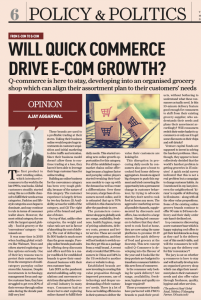Food has always been one of the largest segments of retail. As much as 42% of the Indian retail industry is dedicated to food. It holds similar market shares internationally and is also the largest growing segment.
After all, we think about food at least three times a day, if not more. We wonder what we’re going to eat, what we should eat and what we should buy to make and eat. And because it holds so much importance in the mindscape of consumers, it will always continue to be the largest opportunity for retail growth. Retailers continue to compete with each other by opening new stores and creating new formats to improve market penetration.
I visit different format stores when I shop for food and have noticed that it doesn’t matter which brand I visit, the focus is always the same – price. The items available in stores are the same, the layout and category dividers are similar, the basic in-store experience is the same, the in-shop hoardings are almost always about discounts.

However, it isn’t just these stores that follow this sale philosophy. In metros and in a few other large cities, there is a mushrooming growth of online platforms that sell and home-deliver groceries and vegetables. Here too, the key focus is on price.
The fact is, when most of us consider shopping for food, our first requirement is convenience. I shop for groceries every weekend, but my wife still finds reasons to call the local corner shop almost every day to home deliver something. It is convenient. Our second requirement is range.
We like browsing, picking up the items we like and knowing for a fact that we have a choice in what we buy. Quality is the third important factor while shopping for food and price comes in behind all of them.
This sequence of priorities isn’t just my personal shopping behaviour; it has been accepted internationally as normal consumer attitude. However, most Indian food retailers still work with the belief that price is the key driver of sales. If price truly was the biggest factor, all of us would make special trips to the wholesale market to shop!
So, when we decided to build an online model for fruit and vegetable shopping, we knew that our first focus had to be on customer convenience, then range and quality, all delivered at competitive prices. We wanted to replicate the brick and mortar experience into an online experience – into a ‘click and mortar’ experience — and that was our biggest challenge! The idea was to deliver similar experiences to customers as they would have if they had gone to stores or to a market and shopped themselves.
We decided to offer fruits online and we began with simply, with just one type of fruit. We set down standards for quality, drawing tangible parameters against which we sourced and benchmarked fruit. We ensured that prices were competitive and sustainable. And last mile delivery experience was kept on high focus while building the model. The challenge was to make sure that the products were delivered to the customers’ doorsteps as fresh as though they had bought it from the market themselves. Gradually, we added items and found newer ways of identifying convenience.
It turns out that in the same city, fruit arrives in different markets at different times, sometimes fruit is available in some markets and not in others. Surprisingly, we found that litchis, a fruit so common in North India, was completely alien to some parts of Pune!
With mangoes, we found that though people are very eager to eat them, especially the Alphonso variety, most don’t really know how to buy. A lot of our customers aren’t even sure how much to pay for a dozen and whether what they are buying really is from Ratnagiri.
What’s more, mangoes are available for only a short period of time and none of us want to miss out on it even for a single week. So part of the experience we built was a subscription model. Our members had the option of paying at the start of the summer for an entire season with mangoes door-delivered each week.
With introduction of fruit that is still being treated as ‘novelty’, we are beginning to providing options to buying them per piece: one single apple, two peaches and a handful of plums since quality is assured. We’re also finding ways for our members to ask for the kind of fruit and vegetables they like. They should be able to ask for small size bhindis or radish with leaves. And with more feedback from customers, we’ll only continue to build more experiences like these with focus on convenience, quality and price.
From a series of articles commissioned by DNA (Money) dated 27 June 2012.



